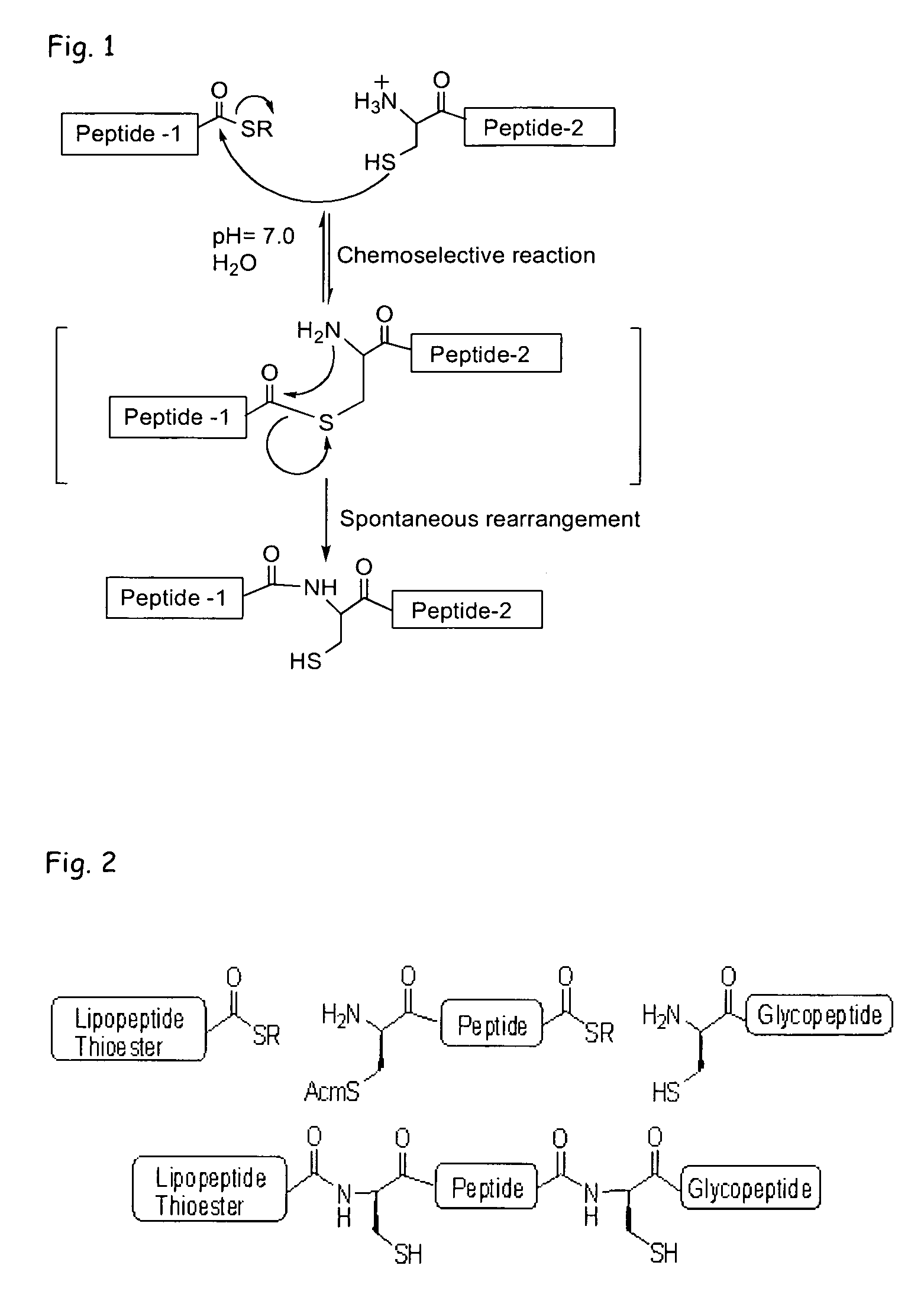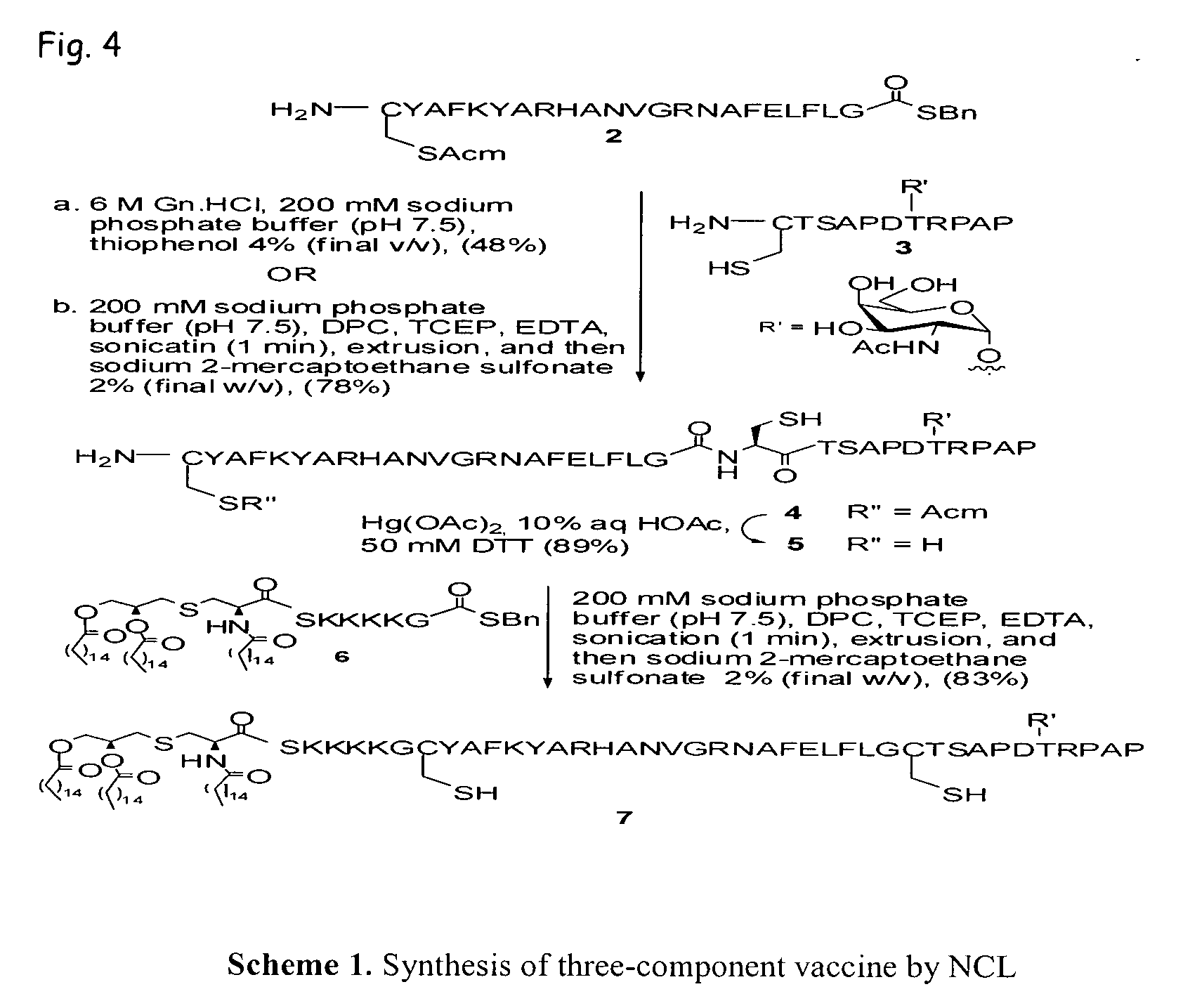Liposome-mediated ligation
- Summary
- Abstract
- Description
- Claims
- Application Information
AI Technical Summary
Benefits of technology
Problems solved by technology
Method used
Image
Examples
example 1
Synthesis of a Three-Component Vaccine Using Liposome-Mediated Native Chemical Ligation
[0085]Recently, we demonstrated (Buskas et al., Angew. Chem., Int. Ed. 2005, 44, 5985-5988) that the three-component vaccine candidate 1 (FIG. 3) composed of the tumor-associated Tn-antigen (Springer, Science 1984, 224, 1198-1206; Kagan et al., Cancer Immunol. Immunother. 2005, 54, 424-430; Toyokuni et al., J. Am. Chem. Soc. 1994, 116, 395-396), the peptide T-epitope YAFKYARHANVGRNAFELFL (SEQ ID NO:2; YAF) (Wiertz et al., J. Exp. Med. 1992, 176, 79-88), and the lipopeptide S—[(R)-2,3-dipalmitoyloxy-propyl]-N-palmitoyl-(R)-cysteine (Pam3Cys) (Spohn et al., Vaccine 2004, 22, 2494-2499; Metzger et al., J. Med. Chem. 1991, 34, 1969-197) can elicit IgG antibody responses. This finding was significant because it had been difficult to elicit relevant immune responses against tumor-associated carbohydrates (Kuduk et al., J. Am. Chem. Soc. 1998, 120, 12474-12485; Danishefsky et al., Angew. Chem. Int. Ed. 2...
example 11
Alternative Ligation Method
[0117]The ligation method described in Example 1 as Method B was refined to yield an alternative ligation method. The alternative method is performed, for example, at a slightly more basic pH. The alternative Method B was exemplified by the following ligation of glycopeptide 14 and lipopeptide thioester 6.
[0118]Method B (alternative). Glycopeptide 14 (1.5 mg, 0.48 μmol), lipopeptide thioester 6 (0.98 mg, 0.58 μmol), and dodecyl phosphocholine (1.5 mg, 4.4 μmol) were dissolved in a mixture of trifluoroethanol and CHCl3 (1 / 1, v / v, 1.5 mL / 1.5 mL). The solvents were removed under reduced pressure to give a peptide / lipid film on the surface of the round bottom flask. The lipid / peptide film was then dried in vacuo overnight. The ligation buffer was prepared by degassing a solution of 200 mM phosphate buffer (pH 7.5) containing tris(carboxyethyl)phosphine (2% w / v) and EDTA (0.1% w / v) in double-distilled H2O for 30 minutes and placing the solution under a strict a...
example iii
Liposome-Mediated Native Chemical Ligation in the Presence or Absence of Thiol Initiator
[0119]Liposome-mediated native chemical ligation between peptide thioester 38 and glycopeptide 39 having a N-terminal cysteine resulted in formation of glyco(lipo)peptide 37 (FIG. 14, Scheme 11). This reaction was carried out in the presence and absence of catalyst required for ligation reaction such as 2-mercaptoethane sulfonate or thiophenol. Surprisingly, this reaction gave similar results, indicating that the thiol initiator is not required under liposome-mediated native chemical ligation. Thus, the liposome mediated native chemical ligation can be performed in the presence or absence of thiol initiator or catalyst.
[0120]The complete disclosures of all patents, patent applications including provisional patent applications, and publications, and electronically available material (e.g., GenBank amino acid and nucleotide sequence submissions) cited herein are incorporated by reference. The foreg...
PUM
| Property | Measurement | Unit |
|---|---|---|
| pH | aaaaa | aaaaa |
| temperatures | aaaaa | aaaaa |
| flow rate | aaaaa | aaaaa |
Abstract
Description
Claims
Application Information
 Login to View More
Login to View More - R&D
- Intellectual Property
- Life Sciences
- Materials
- Tech Scout
- Unparalleled Data Quality
- Higher Quality Content
- 60% Fewer Hallucinations
Browse by: Latest US Patents, China's latest patents, Technical Efficacy Thesaurus, Application Domain, Technology Topic, Popular Technical Reports.
© 2025 PatSnap. All rights reserved.Legal|Privacy policy|Modern Slavery Act Transparency Statement|Sitemap|About US| Contact US: help@patsnap.com



